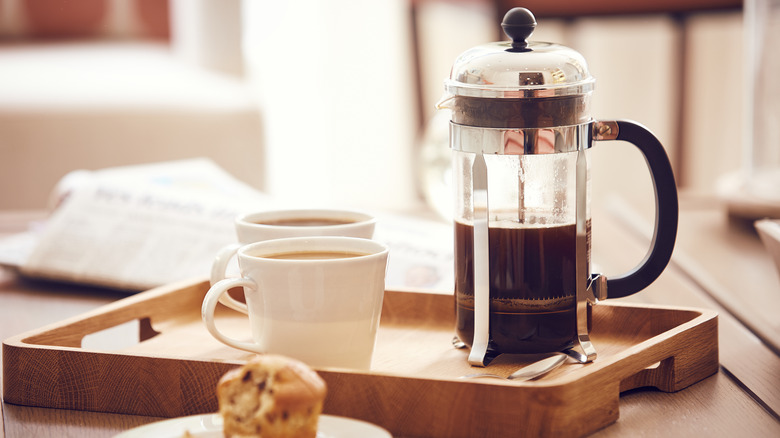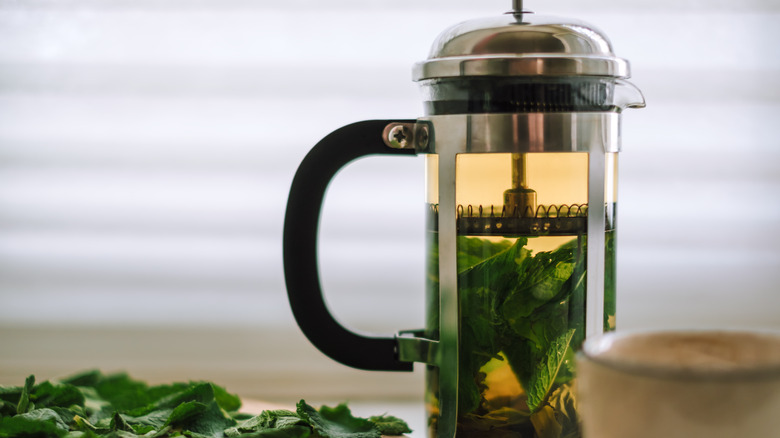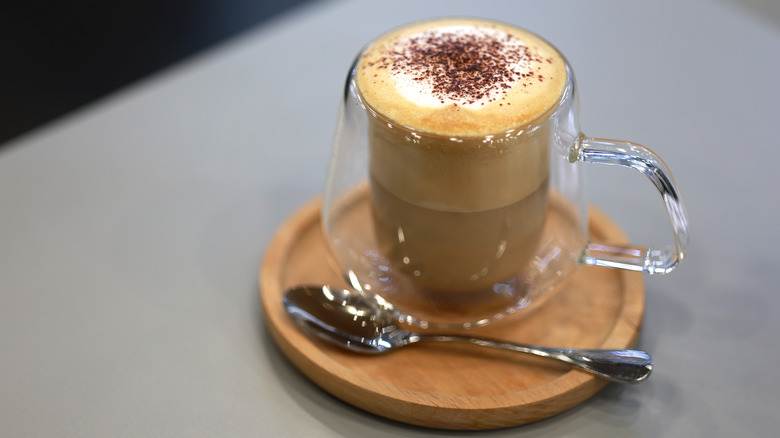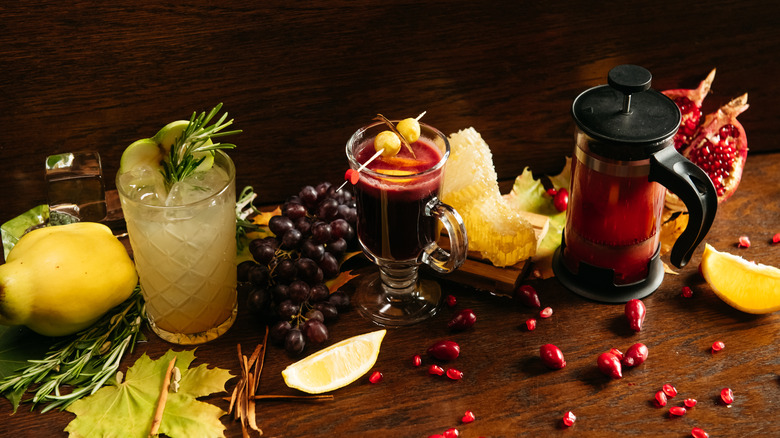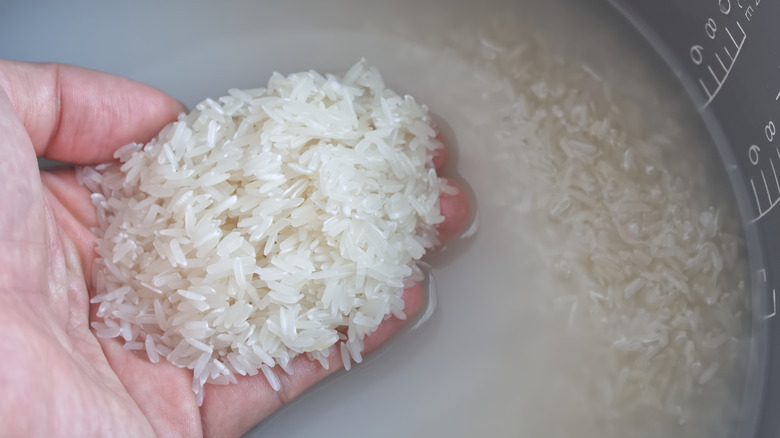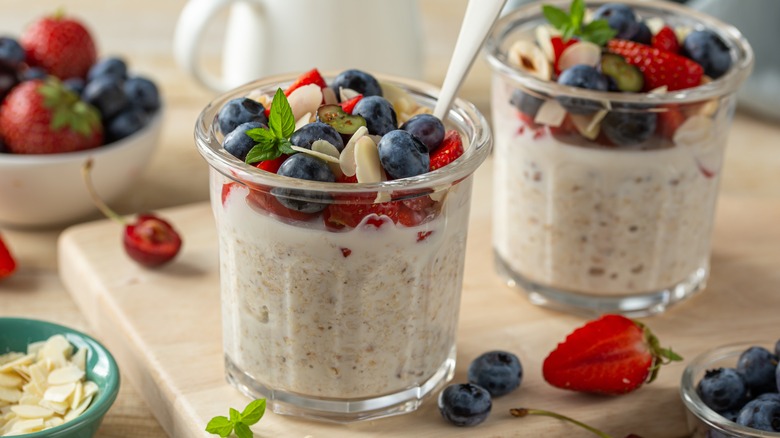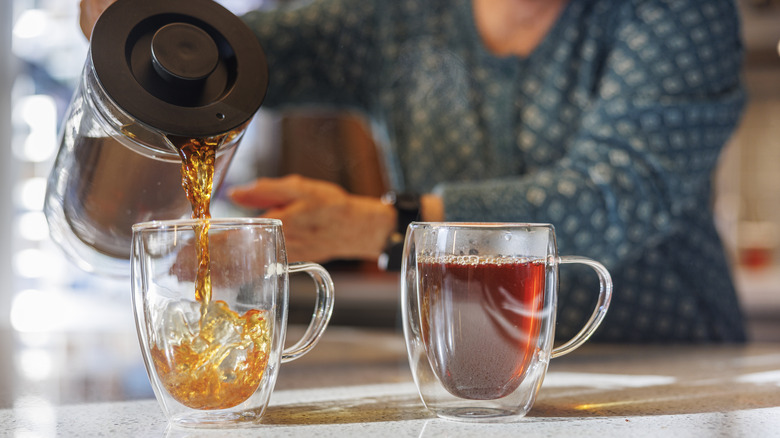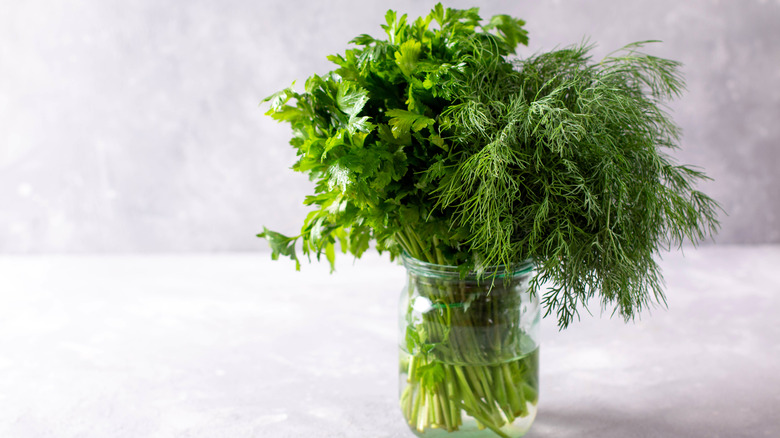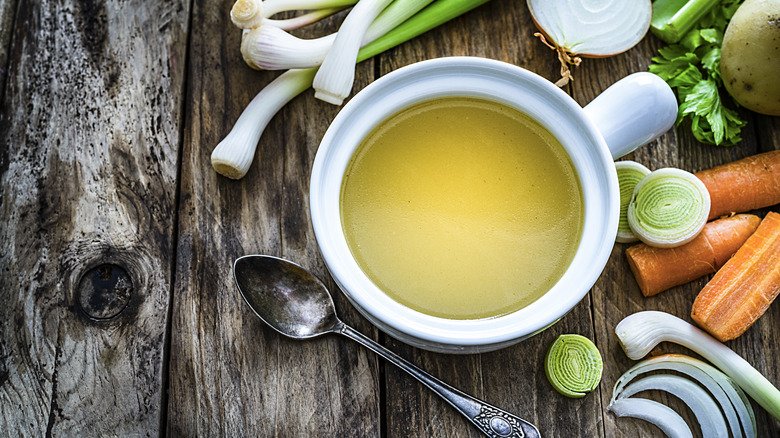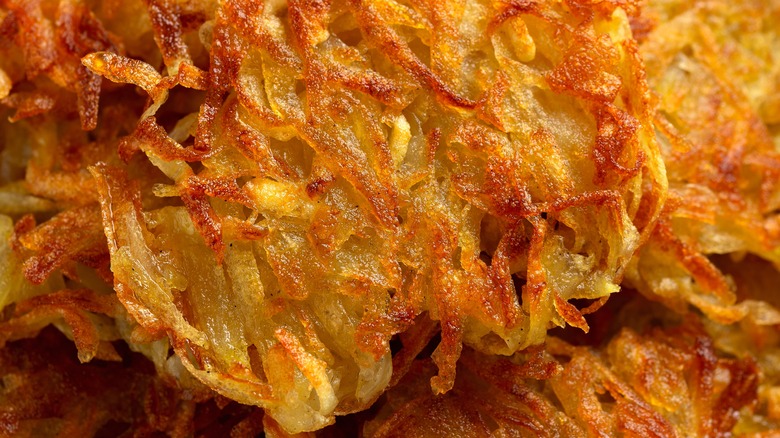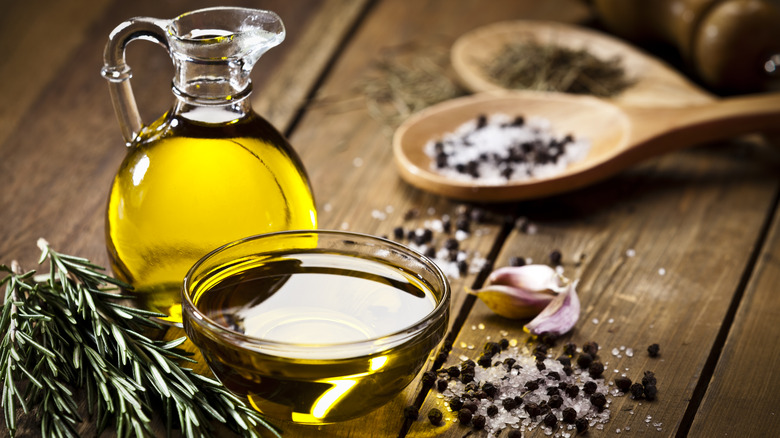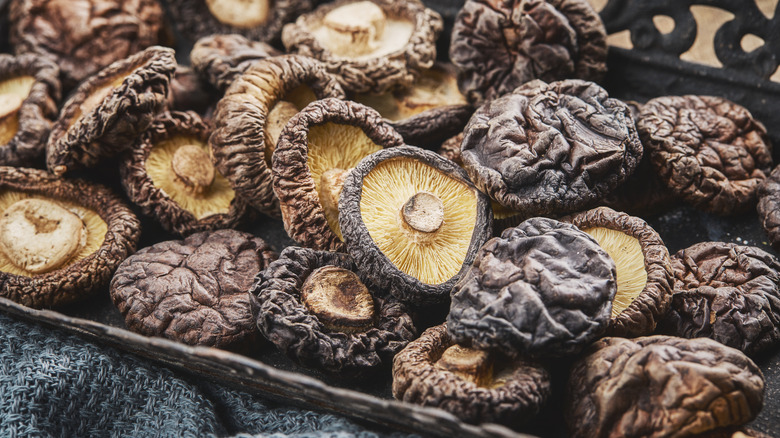14 Uses For Your French Press Beyond Making Coffee
We often sleep on common kitchen tools, forgetting they can be used for more than the task they were designed for. The French press is the perfect example of this as it's one of the most versatile utensils you can have in your kitchen. While a French press (or cafetière) may seem like it only has one function — to make your oh-so-important cup of Joe — there are many different things you can do with this handy kitchen tool.
Not only is it one of the best ways to make coffee without a coffee maker the built-in filter also makes the French press great for straining, rinsing, and frothing. It can even play a role in some simple recipes. So, if you've sworn off caffeine or have an old French press gathering dust in your cupboard, don't give up on it yet. We scoured the internet and used our experience to explore 14 ways your French press can be used without making coffee.
1. Make fresh mint tea
Take advantage of your herb garden and make fresh mint tea in your French press. Fresh mint tea is a common herbal drink in many cultures, including Native American, Indian, and Middle Eastern cuisines. It's often used to alleviate stomach problems or to settle your digestion after a big meal, and it is also a comforting beverage to sip before you fall asleep. While you can buy mint teabags or dried mint tea from the grocery store, you'll probably notice that tea made with fresh herbs has a stronger taste and fragrance.
Making mint tea in your French press could not be simpler. Pull some mint leaves from their stalks and rub or scrunch them slightly to activate the oils. Drop the leaves into your French press, pour some hot water over them, and leave to steep for around 5 minutes.
Once your tea is infused, you can press down the French press plunger to keep the leaves out of your cup. Then, pour it out to drink hot or store it in the fridge to serve over ice. Melt some brown sugar or honey into hot tea for sweetness or season with a squeeze of lemon or lime.
2. Froth milk for a homemade cappuccino
This is a great tip if you make your coffee with an espresso machine but have a spare French press lying around. Start by heating some milk to around 140 degrees Fahrenheit and taking it off the stove before it boils. Pour the milk into your French press and quickly move the plunger up and down for about 30 seconds to add air bubbles. Only fill your French press to the halfway mark or below as your milk will roughly double in volume as it aerates.
While you won't get the stiff, dense peaks you'd get with a steamer, you can certainly make light and fluffy milk that's delightful in a cappuccino or a homemade hot chocolate. You can also pour frothed, warm milk over iced coffee to give it a creamy texture. If you want to make cold brew in your French press, just steep ground coffee beans overnight in the fridge and then strain the liquid over ice when you want to drink it. Just remember to start your brew with room temperature water rather than ice cold water to avoid one of the most common mistakes everyone makes with homemade cold brew.
3. Press soft fruits for fresh juice
If you don't have a juicer or your blender is on the brink, a French press can save you from going without your daily cold-pressed juice. The plungers on many cafetières are not that sturdy – a metal filter might be slightly tougher than a plastic one — so you can't expect to crush raw carrots or celery in your French press. But it is a handy tool for juicing soft fruits, like raspberries, tomatoes, or peeled orange segments.
Even slightly harder fruits, like watermelon or cantaloupe can be juiced in a French press. Simply cut them into chunks and mash them slightly before putting them in your cafetière. Make sure your fruit is fully ripe, as this will make it softer and easier to juice. One easy trick to help you pick a great cantaloupe is to check that the skin is a light, creamy color rather than green.
You can add some cold water before mashing to slightly soften the flesh. Once you've got your fruit in the French press, use the plunger to squeeze out the remaining juice and strain any leftover pulp or seeds. Even with your best efforts, you're unlikely to get a huge yield from this. Still, this is a great hack if you just want a small glass of juice first thing in the morning or if you want to mix fruit flavors for a homemade vitamin shot.
4. Make fruity sangria
At its heart, a French press is essentially a tool for infusing liquids with flavor. This is what happens when you pour hot water over coffee grinds — the liquid takes on the taste of the beans. To make an ultra-fruity sangria, try loading up your press with muddled fruits and alcohol to create a mouth-watering Mediterranean cocktail.
Muddle your mixed fruit in the base of your French press first to help release its flavors. Traditional Spanish sangria ingredients include apples and oranges, but you can also add raspberries, peaches, or even pineapple if you want to give it a tropical twist. You can also add sugar syrup to help sweeten things up. Some sangria recipes call for red wine — pour this into your cafetière and let the fruit steep in it — while others combine red wine and white wine with rum and cognac for a truly punchy summer cooler.
Once you've mixed your fruit and alcohol in the French press, move the plunger slowly up and down 10-12 times, pressing the fruit gently to coax out the juices. Use the filter to strain the mixture as you pour, and serve over ice and fresh fruit slices. You can also infuse tequila with fruit for refreshing summer cocktails, like margaritas or Long Island iced teas, or soak strawberries in your rosé for a fresh, sweet taste.
5. Rinse your grains and starches
The filter on a French press makes it an ideal strainer that's handy for washing dried grains, like rice and quinoa. Using a French press to rinse your grains keeps them contained, meaning you don't have to worry about losing any from your sieve into the sink. Washing grains in a sieve also makes it hard to reach those in the middle, while soaking them in your French press lets the grains move around, ensuring they get a thorough rinse. You can use the plunger to slowly pump the water in your jug, helping it to move the grains.
The filter lets you strain the water once you're done, getting rid of any starch or impurities. Leave your rice to soak in the French press jug before cooking — give it a couple of quick rinses first to clean it — as soaking reduces the cooking time and lowers the rice's natural arsenic content. When your rice has soaked for around 20 minutes, drain the water again and add it to your boiling water.
6. Make overnight oats
Overnight oats are a delicious and super-easy morning meal packed with protein for the day ahead. You can make overnight oats in a French press by pouring in oats, adding the liquid of your choice, and sprinkling in any seasonings, like raisins, seeds, or cocoa. One of the main tips you need to know when cooking oatmeal is not to add too much liquid. This is also true for overnight oats, as you want most of the liquid to absorb into the oats to cook them effectively.
Rolled oats are a good choice for overnight oats as they are slightly softer than steel-cut oats but won't completely disintegrate when soaked. Once you've made your oatmeal in your French press, pop it in the fridge and leave it overnight. In the morning, gently plunge the filter to get rid of any excess liquid that hasn't been absorbed.
You can make overnight oats with milk, water, or plant-based milks. Another tasty option is to soak the oats in cloudy apple juice, then throw in some raisins and cinnamon for a perfect fall treat.
7. Enjoy perfectly steeped loose-leaf tea
To enjoy perfectly steeped loose-leaf tea, you can use your French press like a teapot, soaking the tea leaves in hot water to bring out the natural flavors and aromas. Large French presses make great stand-in teapots if you're entertaining a group. Using a glass cafetière can also look really aesthetic if your tea turns a pretty color or contains dried flower petals.
A glass French press also lets you judge when your tea is ready based on the color inside. If you like your tea strong, you can wait until the liquid turns darker or pour it out while the color is still quite mild.
In general, it's ideal to use 1-2 tablespoons of tea for every 8 ounces of water. Leave your tea to steep for 3-5 minutes and then serve. You can also leave your French press tea steeping in the fridge for 6-12 hours to make cold brew iced tea.
8. Store cilantro in the fridge
Cilantro is a delicate herb that must be kept in the right conditions to stay fresh. To keep cilantro in the fridge, you can use your French press to pull off a clever hack that makes fresh herbs last longer. Pour an inch or two of water into the bottom of your French press and lower the plunger, leaving space between the lid and the top of your press. Take a handful of cilantro with the stalks still intact and stand them upright in the French press so that the stems are resting in the water.
Once the herbs are inside, you can push the plunger down to seal the lid and pop it in your fridge. Cilantro flourishes in a cool environment and can last more than 2 weeks when covered in the fridge. You can also use this trick for other herbs, such as parsley, chives, or fresh mint.
9. Infuse clear broth with flavor
If you've got a simple chicken or vegetable broth and you want to add some other flavors while still keeping it clear, your French press will be your new favorite tool. You can also infuse boiling water with herbs or give your bouillon a spice boost. To get started, finely chop your base ingredients, like onions, garlic, ginger, or chilies, and then muddle these in your French press with your herbs and other aromatics. You can use any seasonings you want — tough or spiky herbs, like lemongrass, rosemary, or bay leaves, that you may want to strain before eating are a good option.
Once you've added the seasonings, simply pour your boiled water or your heated broth into the French press and give the whole thing a stir. Leave your broth to sit for around 5-7 minutes before giving it another quick mix with a spoon. When you're finished, carefully press down the filter and pour out your broth to strain it. You can also make an Asian-inspired broth for noodle soups by infusing your stock with dried kelp, miso, and shiitake mushrooms.
10. Dry shaved potatoes for rostis
Crispy potato rostis are great served with ham and eggs or paired with schnitzel. The key to a perfect rosti is to use shaved potatoes with the all moisture squeezed out, and your French press is the perfect tool for this. You don't need to cook your potatoes before shredding — although you will want to peel them — and you can use a box grater to shave off long, flat potato strands. Once you've shredded your potato, add a few handfuls to your French press and push the filter down firmly to eke out the moisture.
Don't go overboard — you don't want the potatoes completely dry, but you do want most of the excess water removed so that it won't cool the pan when your rosti is cooking. Next, heat butter and oil in a shallow pan and fry your rosti until golden brown. Use a spatula to lightly press down the potato, but don't crush it into the bottom of the pan as this can cause it to stick.
When your rosti is cooked on the first side, flip it over and let it brown on the top. The end result? A crispy, crunchy potato feast with a soft, fluffy center.
11. Add flavor to oils
If you don't mind getting your French press a bit greasy, you can use it to infuse oils with herbs and spices to create fragrant dressings and dips. Whole roasted garlic gloves can add a lovely, herby tang to olive or avocado oil, while chopped chilis can give you a spicy dressing to drizzle over pizza or to add to a stir fry. You can steep as much of the flavoring as you like for as long as you like in a French press, then use the filter to strain the oil. Herbs like rosemary and oregano work well in olive oil and you can also infuse oils with lemon or orange peel to give it a citrusy kick.
When you've finished making your oil, you'll want to give your French press a good clean. Luckily, the plunger mechanism makes this really easy as well. Simply squirt some dish soap into your press and fill it just under halfway with hot water. Move the filter quickly up and down to thoroughly clean it, then run it under the tap to wash off any leftover soap.
12. Rehydrate dried mushrooms
Many specialist mushrooms, like shiitake mushrooms, porcini mushrooms, and trumpet mushrooms, are dehydrated to give them a longer shelf life. Dehydrating mushrooms doesn't undermine the nutrient content or the flavor of these earthy little morsels, either. For example, the dried mushrooms noted here are loaded with potassium and have a high concentration of vitamins.
Dried mushrooms work particularly well in plant-based dishes when you want to add depth of flavor or for seasoning Asian dishes with a strong umami taste. To prepare dehydrated mushrooms, you'll need to reintroduce some moisture before you start cooking, and your French press is the perfect place to soak them. The filter will also clean them for you, washing off any impurities.
Your French press can reinvigorate other dried foods you might have in your kitchen. Soak raisins in brandy or fruit juice before adding them to a cake, or rehydrate dried cranberries or mango by steeping them in hot water for 10-20 minutes.
13. Make hoppy beer
Whether you buy bottled beer or you make a mean homebrew, you can use your French press to enhance the hoppy flavor in your beer. The process is extremely simple — just pour some beer into a French press and drop in your dry hops. Remember not to fill the press right to the top to prevent it from overflowing and keep the hop package sealed, to preserve the flavor, right up until you're ready to use it.
If you like your beer really hoppy, you can add up to an ounce of hops to your press. Then, tweak the amount if you find the results are too potent. Allow the beer and hop mix to sit for around 3 minutes then gently plunge the top. The filter lets you pour clean, hop-infused beer into your glass, so all you have to do is sit back and enjoy.
14. Serve homemade apple cider with an extra kick
Homemade apple cider is fairly quick and easy to make and is perfect to sip on a summery day or drink warm on a cosy, fall afternoon. To perfect homemade apple cider, you'll need to simmer about 10 apples with water in a large pot with cloves, cinnamon, all-spice, nutmeg, and brown sugar. You don't need to peel the apples, as the skin will impart extra flavor to the drink. Once your apples have cooked for around 2 hours, take them off the heat and mash them vigorously, then put them back on the stove to cook for another hour.
Once the cider is cooked, pour it into a French press to serve, allowing the strainer to filter out the whole spices and any remaining apple lumps. You can also add lime or orange slices to your French press to give your cider an extra sharp kick.
